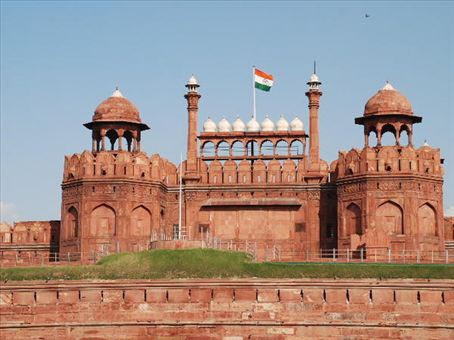Red Fort Delhi (Lal Qila)

Information on Red Fort / Lal Qila (New Delhi) - History & Architecture
India has some of the beautiful and ancient monuments that date back to centuries old. The capital of India, the city of New Delhi has been under the reign of various kings and emperors over a long period of time. This means that there are many such beautiful amazingly enchanting monuments. One such is the Red Fort also called the 'Lal Qila' in India. This eminent fort was the place of shelter for the Mughal emperors for more than 200 years. Mughals came to India in 17th century and stayed until the mid-19th century and while they were here in India, they built some of the greatest monuments.
Red Fort Delhi (Lal Qila) Architecture
This fort has a massive area of 254.67 acres which is protected by huge walls that run for 2.41 kilometres. These walls are huge and strong which was built for defence centuries ago. The walls itself is one master piece for it has tunnels, stairways, turrets and bastions that punctuated the architecture of the walls. They connected the city to the other side of the river that used to flow there during olden days. The height of the walls was up to 108 feet. Such importance was given to the detailing of the protective fence so one can only imagine how the inside of the fort would be like.
An aerial view of the fort will tell you that it has an octagonal shape with north and south axis being longer than the east and west axis. When it comes to the designing skills of the Mughals, it is extravagantly shown in here. The floral designs and the intricately designed domes are eye catching. Some of the most prominent structures that still remains after all these years are the Lahori Gate, Delhi Gate, water gate, Chhatta chowk, Naubat Khana, Diwan-i-Aam, Mumtaz Mahal, Rang Mahal, Khas Mahal, etc.
Red Fort Delhi (Lal Qila) History
The construction of the Red Fort began when the capital of the Mughal emperor was shifted from Agra to Delhi by Shahjahan. When the construction began in 1643, the designer of the monument Ustad Ahmad Lahauri saw that right next to the Yamuna River would make the right area for the fort to be built. Under the supervision of Shahjahan the construction to begin in the month of Muharram and it contains the old Salimgarh fort making it a first of asymmetrical Mughal fort. In the medieval era this fort was the focal point of the old Delhi, making it the heart of all major affairs. During the Shahjahan's rule the creativity of Mughal rule reached its peak.
After Aurangzeb took over, the fiscal structures of Mughals started declining and that's when the most part of the Red Fort was also damaged. Slowly as successors took over either for money or for other silly reasons the decorum and the structure of the fort was destroyed.
Red Fort Delhi (Lal Qila) Modern Day Significance
However, today also the Red Fort stands tall in the hustling bustling city of New Delhi and it attracts huge tourist from all over the world. It is the place where every year on 15th August the national flag is hoisted by the country's Prime Minister.
- Andaman Nicobar Monuments
- Andhra Pradesh Monuments
- Assam Monuments
- Bihar Monuments
- Chhattisgarh Monuments
- New Delhi Monuments
- Goa Monuments
- Gujarat Monuments
- Haryana Monuments
- Himachal Pradesh Monuments
- Jammu and Kashmir Monuments
- Karnataka Monuments
- Kerala Monuments
- Madhya Pradesh Monuments
- Maharashtra Monuments
- Odisha Monuments
- Punjab Monuments
- Rajasthan Monuments
- Tamil Nadu Monuments
- Telangana Monuments
- Uttar Pradesh Monuments
- West Bengal Monuments